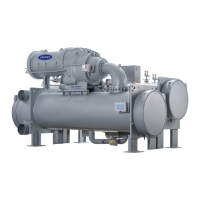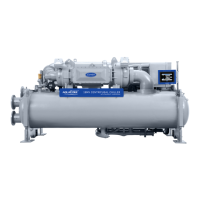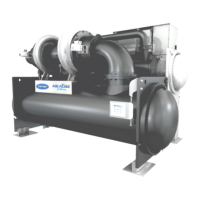22
Checking the Installation — Use the following
instructions to verify the condition of the installation:
1. Turn off, lock out, and tag the input power to the drive.
2. Wait a minimum of 5 minutes for the DC bus to discharge.
3. All wiring should be installed in conformance with the
applicable local, national, and international codes (e.g.,
NEC/CEC).
4. Remove any debris, such as metal shavings from the
enclosure.
5. Check that there is adequate clearance around the
machine.
6. Verify that the wiring to the terminal strip and the
power terminals is correct and that no external voltage
potential are connected to any of the inputs.
7. Verify that all of the VFD power module circuit board
connectors are fully engaged and taped in place.
8. Check that the wire size is within terminal specifica-
tions and that the wires are tightened properly and ade-
quately supported.
9. Check that specified branch circuit protection is in-
stalled and correctly rated.
10. Check that the incoming power is within ±10% of
chiller nameplate voltage.
11. Verify that a properly sized ground wire installed and a
suitable earth ground is used. Check for and eliminate
any grounds between the power leads. Verify that all
ground leads are unbroken to the power supply. Only a
wye secondary power supply transformer with solidly
grounded neutral is acceptable as a power supply to
this chiller.
Inspect Wiring
1. Examine the wiring for conformance to the job wiring
diagrams and all applicable electrical codes.
2. Connect a voltmeter across the power wires to the
VFD and measure the phase to phase and phase to
ground voltage. The voltage imbalance for these two
measurements should be consistent. If not, confirm the
power supply to the chiller is a wye configuration with
solidly grounded neutral. Compare this reading to the
voltage rating on the compressor and VFD nameplates.
3. Compare the ampere rating on the VFD enclosure name-
plate to the rating on the compressor nameplate.
4. The VFD must be wired to components and terminals re-
quired for PIC5 refrigeration control. Check line side
power and control components shown on the certified
prints.
5. Ensure that fused disconnects or circuit breakers have
been supplied to the VFD.
6. Ensure all electrical equipment and controls are properly
grounded in accordance with the job drawings, certified
drawings, and all applicable electrical codes.
7. Ensure the customer’s contractor has verified proper op-
eration of the pumps, cooling tower fans, and associated
auxiliary equipment. This includes ensuring motors are
properly lubricated and have proper electrical supply and
proper rotation. The 19DV unit must maintain pump con-
trol through the IOBs/Carrier Control Panel for freeze
prevention algorithm.
8. Verify tightness of all wiring connections on the high and
low voltage terminal blocks in the VFD enclosure.
9. Inspect the control panels and VFD enclosure to ensure
that the contractor has used the knockouts or provided
top hat to feed the wires into the enclosures. Generally,
wiring into the top of the enclosures can allow debris to
fall into the enclosures. Clean and inspect the interior of
the power panel and VFD enclosure if this has occurred.
If metal particulate has fallen into the rectifier or invert-
er assemblies contact Service Engineering or your Tech-
nical Service Manager for further instructions.
VFD PROTECTION AND OTHER INCOMING WIRING
1. Verify that the branch disconnects or other local discon-
nects are open and properly tagged out.
2. Verify that the branch circuit protection and AC input
wiring to the starter are in accordance with NEC (Nation-
al Electrical Code) and all other applicable local codes.
3. Verify that the fuses are per the field wiring diagram.
4. Verify that the incoming source does not exceed the
SCCR (short circuit current rating) of the equipment
marking.
5. Verify the power lugs in the starter/VFD and branch pro-
tection are properly secured. Inspect the ground cable and
ensure it is properly connected at the branch and to the
ground lug in the starter.
6. Verify the conduit for the power wiring in securely con-
nected to the starter flanged cover and runs continuously
to the branch protection.
7. Ensure the control and signal wires are in separate con-
duits from any power wiring greater than 24v.
Ground Fault Troubleshooting — Follow this pro-
cedure only if ground faults are declared by the chiller con-
trols. Test the chiller compressor motor and its power lead
insulation resistance with a 500-v insulation tester such as a
megohmmeter.
1. Open the VFD main disconnect switch and follow lock-
out/tagout rules.
2. With the tester connected to the motor leads, take 10-sec-
ond and 60-second megohm readings as follows:
Tie terminals 1, 2, and 3 together and test between the
group and ground.
3. Divide the 60-second resistance reading by the 10-second
reading. The ratio, or polarization index, must be one or
higher. Both the 10 and 60-second readings must be at
least 50 megohms.
WARNING
Do not check the voltage supply without proper equipment
and precautions. Serious personal injury may result. Follow
power company recommendations.
CAUTION
Do not apply any kind of test voltage, even for a rotation
check, if the chiller is under a dehydration vacuum.
Insulation breakdown and serious damage may result.
WARNING
Do not apply power unless a qualified Carrier technician is
present. Serious personal injury may result.
CAUTION
The motor leads must be disconnected from the VFD
before an insulation test is performed. The voltage gen-
erated from the tester can damage the VFD.

